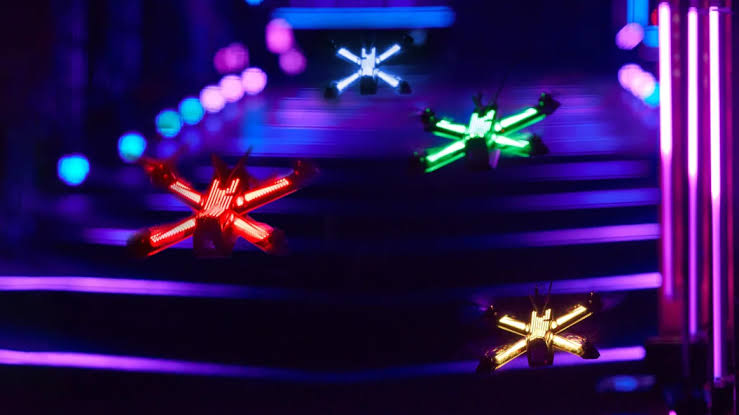Drone racing
Welcome to the Future of Racing: Drone Racing Takes Flight
In the world of high-speed sports, a new competitor has taken to the skies—drone racing. Combining cutting-edge technology, lightning-fast reflexes, and adrenaline-pumping action, drone racing is rapidly becoming one of the most thrilling sports of the 21st century. It is the intersection of entertainment and engineering, and it is capturing the imagination of technology enthusiasts, gamers, and athletes worldwide. What Is Drone Racing?
Drone racing is a competitive sport where pilots fly small, agile quadcopters through complex racecourses at incredibly high speeds. Neon-lit gates, tight turns, and tunnels are typical features of these courses, which are frequently set up inside or in specially designed arenas. Using First Person View (FPV) goggles, racers experience the flight from the drone’s perspective in real-time, as if they were sitting inside the cockpit.
The drones used in racing are built for speed and agility. Unlike camera drones used for photography, racing drones are stripped down for maximum performance—lightweight, fast, and incredibly responsive. Some can reach speeds of over 120 km/h (75 mph) and make split-second maneuvers through narrow obstacles.
The Rise of the Drone Racing League (DRL)
The Drone Racing League (DRL) is one of the most well-known platforms that has brought drone racing into the mainstream. Founded in 2015, DRL has revolutionized the sport with professional-grade drones, immersive visuals, and global competitions. Events are broadcast on major sports networks like ESPN and Sky Sports, drawing millions of viewers who tune in to watch elite pilots navigate visually stunning courses.
The DRL also brings an esports flavor to drone racing, with many racers competing both virtually (in simulators) and in real-world environments. In fact, the DRL Simulator allows aspiring pilots to train and even qualify for professional events from the comfort of their homes.
How does it function? Each pilot controls their drone using a specialized radio controller while wearing FPV goggles. The drones are equipped with forward-facing cameras that transmit live video to the goggles via low-latency analog or digital signals. Pilots must navigate at high speeds through gates and around obstacles while avoiding collisions.
Races are timed and judged based on speed, precision, and control. A single mistake can mean the difference between victory and a crash. The sport requires nerves of steel, spatial awareness, and excellent hand-eye coordination. Tech Behind the Thrill
Drone racing is as much about technology as it is about competition. Pilots and engineers constantly tweak their machines for better performance, experimenting with:
Brushless motors for greater efficiency and power.
Carbon fiber frames for light weight and durability.
High-C LiPo batteries that deliver intense bursts of power.
Custom firmware for ultra-responsive flight control.
Innovation is constant, and the barrier between virtual and real-world racing continues to blur thanks to simulator integration and augmented reality.
Reasons Why Drone Racing Is Increasingly Popular 1. Immersive Experience: FPV racing gives pilots a surreal, almost video game-like experience, blending virtual visuals with physical performance.
2. STEM Engagement: Drone racing has educational value, encouraging kids and teens to learn about robotics, coding, aerodynamics, and electronics.
3. Global Community: From local parks to international leagues, drone racing has built a passionate, welcoming community of pilots and fans.
4. Career Opportunities: Top racers have become celebrities in their own right, earning sponsorships, cash prizes, and tech industry attention.
Drone Racing for Beginners
Getting started in drone racing is more accessible than ever. Many starter kits include a drone, remote controller, FPV goggles, and spare parts. Additionally, beginner simulators like: Liftoff
Velocidrone
DRL Simulator
These platforms replicate real-world drone physics and racecourses, helping new pilots develop skills before investing in expensive hardware.
The Future of Drone Racing
With the rise of AI, machine learning, and autonomous drones, the future of drone racing is incredibly exciting. Competitions may eventually pit human pilots against AI-driven drones, creating new dynamics and storylines. We may also see the sport integrated into augmented reality gaming, smart cities, and even education.
As technology advances, drone racing will only become more immersive, competitive, and inclusive. It is more than just a pastime; it is a glimpse into the sports of the future, where human skill and digital innovation will coexist. ---
Conclusion
Drone racing is more than a sport—it’s a movement. It captures the spirit of exploration, the thrill of competition, and the power of technology. Whether you're a pilot, a spectator, or a curious newcomer, drone racing offers a high-octane experience that defies gravity and fuels imagination. Strap in, power up, and prepare to race the future.


Comments
Post a Comment